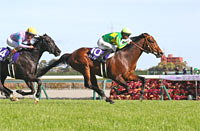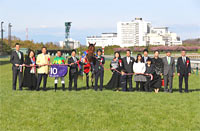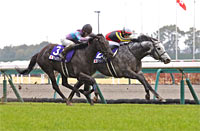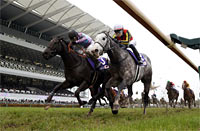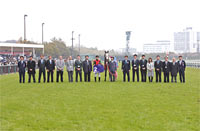2021 News
Takamatsunomiya Kinen (G1) - Data AnalysisSpring sprint champion decider for older horses with long history of upsets The Takamatsunomiya Kinen produced substantial Trifecta payouts of JPY4,497,470 in 2019 and JPY217,720 in 2020. Only two of the race favorites over the last 10 years finished in the Top 2: winner Lord Kanaloa in 2013 and winner Big Arthur in 2016. This is a race in which both fancied runners and dark horses that are expected to deliver a strong performance warrant attention. Let’s now analyze some features shared by successful runners in this race based on results over the last 10 years. Focus on past racing record Of the 30 Top 3 finishers in the last 10 years, 28 runners had experience of finishing in the Top 2 of “a graded turf race held at one of the four major JRA racecourses (Tokyo, Nakayama, Kyoto, and Hanshin Racecourses) since the previous year.” Conversely, runners without such experience struggled with a Top 3 ratio of 2.7%. Incidentally, Hong Kong-trained Aerovelocity, who won the 2015 race, had not previously contested a JRA race but had won the Hong Kong Sprint (G1) in 2014. This suggests we should lower our expectations of runners that have only finished in the Top 2 of the other racecourses (Sapporo, Hakodate, Fukushima, Niigata, Chukyo, and Kokura Racecourses), dirt races, open-class races, or allowance races. [Table 1] [Table 1] Performance by experience of finishing in the Top 2 of "a graded turf race held at one of the four major JRA racecourses (Tokyo, Nakayama, Kyoto, and Hanshin Racecourses) since the previous year (last 10 years)
Sluggish performance by runners that had finished 6th or lower in previous race Of the 30 Top 3 finishers in the last 10 years, 26 had finished in the Top 5 of their previous race. Meanwhile, runners that had finished 6th or lower struggled with a Top 3 ratio of 5.4%. In other words, runners that were strong performers last time out tend to do well in this race. [Table 2] [Table 2] Performance by finish in the previous race (last 10 years)
Of the runners that had finished 6th or lower last time out, those with no experience of winning “a graded race at the racecourse where the Takamatsunomiya Kinen was held in the same year (Hanshin Racecourse up to 2011, Chukyo Racecourse from 2012)” had a poor Top 3 ratio of 1.6%. This suggests we should lower our expectations of runners that have finished their previous race 6th or lower unless they have previously performed well at Chukyo Racecourse. [Table 3] [Table 3] Among runners that had finished 6th or lower in their previous race, experience of winning “a graded race at the racecourse where the Takamatsunomiya Kinen was held in the same year (Hanshin Racecourse up to 2011, Chukyo Racecourse from 2012)” (last 10 years)
Favoritism in previous race is also a key factor Looking at performances by runners that had contested “a domestic race” in their previous race in terms of favoritism in that race, we find that runners that had been backed as race favorites achieved an excellent Top 3 ratio of 38.7%. Conversely, runners that had been backed as “5th favorite or lower” struggled with a Top 3 ratio of 5.7%. When comparing the lead-up races of this year’s runners, we should focus on runners’ favoritism in their most recent outing. [Table 4] [Table 4] Among runners that had contested “a domestic race” last time out, performance by favoritism in that race (last 10 years)
Need to lower expectations of horses aged 7 or above Of the 30 Top 3 finishers in the last 10 years, 27 were aged 6 or below. Meanwhile, horses aged 7 or above struggled with a Top 3 ratio of 5.7%. In addition, if we limit our analysis to the last nine years since 2012 (races held at Chukyo Racecourse), the performance was [1-0-0-45] (Top 3 ratio of 2.2%). If we limit our analysis to the last five years since 2016, the performance was [0-0-0-28] (Top 3 ratio of 0%). In other words, we need to discount horses aged 7 or above. [Table 5] [Table 5] Performance by age (last 10 years)
Runners occupying the inner brackets have basically had an edge in recent years Of the 15 Top 3 finishers over the last five years, 13 started in “Brackets 1-4”. Conversely, runners that started in “Brackets 5-8” struggled with a Top 3 ratio of 4.0%. While runners starting in Bracket 1 delivered performance of [0-0-0-10] (Top 3 ratio of 0%), runners starting in the inner brackets on the whole have had an edge in recent years. [Table 6] [Table 6] Performance by bracket number (last five years)
In addition, the two runners that finished in the Top 2 despite starting in “Brackets 5-8” both entered a race with an 18-horse field last time out and were positioned 2nd or higher when passing the 4th corner in that race. Among runners starting in the outer brackets, we should slightly raise our expectations of those that led the pack in a large-field race last time out. [Table 7] [Table 7] Among runners that started in “Brackets 5-8” and had contested “a domestic race” in their previous outing, performance by position when passing the 4th corner in previous race and number of runners in previous race (last five years)
Seek out the winner! [Table 8] Winners’ performance by body weight in previous race, highest finish in “a graded turf race held at one of the four major JRA racecourses (Tokyo, Nakayama, Kyoto, and Hanshin Racecourses), and favoritism in previous race (last five years)
(Masaya Ibuki) |
|














